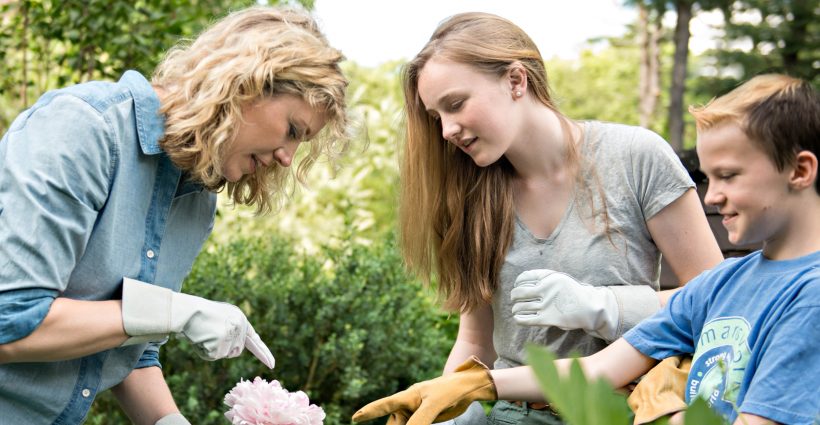designed for the way women work.

Plant Experiments are a good way to keep kids interested in Gardening!
Category: Plant Ideas & Info, Presenting "The Curious Gardener"

We interviewed Rochelle Greyere, garden writer and designer, about creative ways she engages her kids in gardening. Rochelle is also featured in our current catalog for her extensive peony collection, but more on that later.
“Plant experiments are an easy way for adults to help their kids continue to connect to the garden as they get older and into the teen years,” says Rochelle. “As my kids get older, it is harder to get them to join me for some hands on digging in the dirt – but if they are doing a science project they can have different motivations and it still keeps them interested.”
“In our household we have done a huge variety of science projects. Here are just a few of them:
- We’ve tested a selection of cut flower treatments to see which work the best;
- We’ve tested a variety of snow-melt products on plants to see what the implications are;
- Most recently we reverse engineered the Martian movie by obtaining a product that is a very accurate and good simulation of Martian soil and we tried planting things in it and seeing if we could phyto-remediate some of the issues that make it is less capable of sustaining plant life (lots of soil testing involved!).”
I also follow Rochelle on Instagram (@pithandvigor), where I was charmed by a post about teaching her kids to learn the Latin names of plants. She writes: “As a mom, I want to teach my kids about things that I love and that they might not learn elsewhere. So, I quiz them on Latin plant names. They always fall for me pitting them against each other in friendly competition…and the thing that unifies them is their disbelief of the answers when I inevitably have to reveal the name.
They always accuse me of making up words. Like Fothergilla. It was named after a guy called Dr. Fothergill, by a guy named Dr. Garden. I swear I do not make this stuff up. The plant makes us all think of the dad of a big old dangerous lizard that lives in AZ. (Gila monster). Random, but I bet you will now always remember this pretty spring plant name when you next see it.”
Rochelle’s Peonies
Rochelle grew up in Colorado, but spent time at the family ranch in Montana where her grandmother grew “hedges and hedges of peonies,” as she remembers it. They were a dark burgundy and adapted well to the zone 3 climate.
When Rochelle and her husband moved to Massachusetts years later, she wanted her grandmother’s peonies to be one of the cornerstones of her garden. She divided and carried the bare root plants across country to her zone 5 garden and has added more as well. Today she has a sizeable peony display every spring at her 6 acre property.
From Rocket Scientist to Gardening Professional
Rochelle’s path from Colorado to Massachusetts took a few turns along the way. Trained in physics, she worked on software to fly satellites and F-18 flight simulators, among other applications. After taking a position in England, the company she was with abruptly downsized and she was out of a job.
Simultaneously Rochelle went to the Chelsea Flower Show in London and “it changed my life,” she says. She started taking classes at the English Gardening School and eventually got a degree in landscape design. She spent a total of 4 years in England studying and starting a design business there. She gave birth to her daughter. The family moved back to the States 12 years ago.
I first learned about Rochelle through her newspaper, and now blog, Pith + Vigor. http://www.pithandvigor.com/ She writes unusual stories like “How to be your own garden designer: Think Like a Curator”, or “An Insider Tour of a Spectacular Garden in Florence.” It’s a combination of travel stories and thought provoking design questions, plus some quirky How To topics such as “How to Trim a Perfect Spiral Topiary (with tape).”

Rochelle’s Tips on Growing Peonies
–Rochelle says she often gets asked why a peony plant isn’t blooming. Her answer? “It is almost always due to depth of planting. Planting a peony too deep will cause it to not bloom. Try gently lifting the roots so that the top, where the eyes (the points which the plants grow from) are between 1/2″ to 2″ deep. When I need to lift peonies, I do it late in the season after the foliage has started to die back. I try not to take them fully out of the ground if I don’t need to – rather I use a pitchfork to get underneath and lift (backfilling) while disturbing as few roots as possible.
If they need to be fully lifted (or moved) then I dig very wide (18″ in diameter at least to damage as few roots as possible) and then move.
–Warm water helps to open tight peony buds rapidly. Putting cut stems in warm water will generally do the trick, but if your buds are really tight and not opening, you can also turn them upside down and soak the head in warm water as well. Soaking the heads will help open the flowers immediately – try it for a few seconds up to a couple minutes as needed.
–Every year I tell myself I need to stake before they get more than 6-8 inches out of the ground. Everything comes on so fast at that time of year, so stake early -well before you need it – because by the time you need it it is really too late and hard to do effectively. Try making a grid of string ties between 4 stakes so that they grow through them and are supported along the way. I’ve seen this done to excellent effect. I will try and take that advice myself…. next year.”
Below: Rochelle’s daughter is holding peonies from their garden, wearing Womanswork goatskin garden gloves.
This article was updated and reprinted from an earlier article on “The Curious Gardener” in October 2017.



